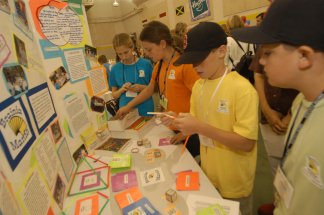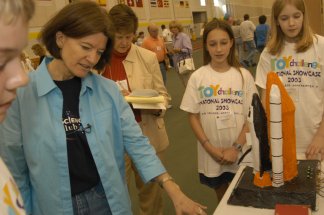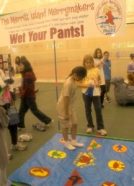Toy Challenge
A toy design contest encourages both girls and boys to take an interest in engineering.
By Emily Sohn
You probably have a favorite game that you just can’t wait to play. Your friends might have their own ideas about what’s fun and what’s not. Have you ever thought about joining forces and creating a game that everyone would love?
Well, here’s your chance. The deadline for this year’s TOYchallenge competition is coming up. Organized by the Sally Ride Science Club and Smith College and sponsored by the toy company Hasbro, the contest challenges teams of middle school students to design a game or toy related to science or engineering. At least half of each team must be girls.
In the 2003 competition, a team of kids from Stockton, Calif., invented an award-winning game called “Brainia Mania.” Players of the game had to answer questions about science and engineering correctly to obtain building materials to create a structure. Wrong answers meant losing essential supplies.
 |
|
Members of the Brookside White team from Stockton, Calif., setting up their prize-winning game “Brainia Mania” at the 2003 TOYchallenge. |
| Hasbro |
You can learn more about the upcoming TOYchallenge at http://www.toychallenge.com/ . The deadline for registering a team is Jan. 30, 2004.
The contest’s organizers hope that kids will learn more about design, teamwork, and engineering. Toy companies are watching closely to see what kids think is fun. Perhaps most important of all, TOYchallenge aims to get more girls interested in science.
Changing interests
Equal numbers of boys and girls like math and science in fourth grade, according to the National Center for Education Statistics in 2000. By eighth grade, twice as many boys as girls show an interest in these subjects.
Another government study also found that middle school girls seem to have less confidence in their math abilities than boys do, even though their grades are just as good.
Things get worse in later years. In the United States, women fill less than 20 percent of all jobs in science, engineering, and technology. Only 9 percent of engineers are women.
And a measly 4 percent of engineering professors at colleges and universities in the U.S. are women, says Domenico Grasso, director of the engineering program at Smith College in Northampton, Mass.
Even women who do end up as engineers tend to make less money than their male colleagues. These statistics are especially troubling, considering that eight of the ten fastest growing jobs involve math, science, or technology.
At Smith College, home of the first and only engineering program at a college open only to women, Grasso is doing his best to lure more women into math and science. Instead of dwelling on abstract concepts that often seem to drive women away, Smith’s engineering program focuses on real-world applications.
Building houses, driving cars, getting clean water, and cleaning up toxic waste all involve engineering, Grasso says.
“There’s nothing that anyone on this planet can say they do from the day they’re born until the day they die that has not somehow been affected by an engineer,” says Grasso, an environmental engineer himself.
The engineering program at Smith has been so successful in its first 3 years, he says, that more students join the program than drop out every year. Most other engineering programs lose up to 60 percent of their students each year.
Role models
Getting more college women into science might be one way to inspire younger girls. At this point, there just aren’t many role models for girls in science. Children’s science programs, for example, feature three times as many male characters as female characters and twice as many men scientists as women scientists.
 |
|
Former astronaut Sally Ride discussing “Fill It Up—A Space Challenge” with the Space Racers team from Newton, N.H., during TOYchallenge judging. |
| Hasbro |
And middle school seems to be the most important time to target girls, many experts say, because that’s when interest in science often begins to drop off.
The problem is often social, says Carrie Strasburger, a science teacher at Williamsburg Middle School in Arlington, Va.
When girls reach sixth grade, they tend to start thinking that they earn good grades not when they perform well but because teachers like them, she says. Middle school girls also grow wary of taking risks and failing in front of other kids.
“We have got to create an environment at the middle school level to really provide a safe opportunity where young women feel confident,” Strasburger says.
She has found hope in the Sally Ride Science Club. Sally Ride was the first American woman astronaut to go to outer space. The club is part of Ride’s efforts to connect hundreds of thousands of girls across the country to role models and other resources in science.
For her own satellite club, Strasburger has invited women scientists to meet with girls at her school. Visitors have included a materials engineer who designs makeup for Revlon, an anthropologist who digs for Neandertal bones in Spain, and an animal trainer who coaches dogs to perform in TV shows and movies.
The program has been a big hit, Strasburger says. “It gives girls the sense that science isn’t a little gray-haired lady with a lab coat and 3-inch-thick glasses on,” she says. “Science is much more than that.”
Designing toys
Last year’s TOYchallenge competition drove that message home. Two all-girl teams from Strasburger’s club traveled to Massachusetts for the finals of the competition in June. Neither group won any of the grand prizes, which included a week at Space Camp and tours of NASA’s Kennedy Space Center. But the girls did get to meet Sally Ride. They even appeared on a segment of ABC’s Good Morning America.
 |
|
TOYchallenge attendee trying out “Wet Your Pants!” The game was created by the Merritt Island Merrymakers team from Merritt Island, Fla. |
| Hasbro |
Seventh-grader Natalia Froberg was one of Strasburger’s students who went to the competition. Her group designed a board game called “Space Race.” Players have to answer trivia questions to earn pieces of the space shuttle. The winner is the first to complete a shuttle and launch it into space.
Everything about the project was a learning experience, Natalia says. The research took more time than she expected, for one thing, and her group found all sorts of surprising challenges along the way.
“Making a board game is much harder than it looks,” says Natalia, 12. “You have to get measurements about how big the board is going to be, what the pieces are going to be like, if it’s going to have trivia questions, and what the object of the game is.”
The work paid off, Natalia says, because the group made something that anyone can enjoy. “We like doing board games,” she says, “because they’re easy to play and everyone likes them.”
Natalia wants to be an astronomer when she grows up. Thanks to programs for girls like the Sally Ride Science Club, she is already one step ahead of the game.
Now it’s your turn. What sort of game or toy would you design? A robot or some other interactive toy? A toy that helps teach? A game for little kids or the whole family? A new outdoor toy or sporty game? A construction set? The 2004 TOYchallenge competition is under way.
News Detective: Emily Recalls an Unusual Trek
Polling Place: Inventing a Game
Going Deeper:







